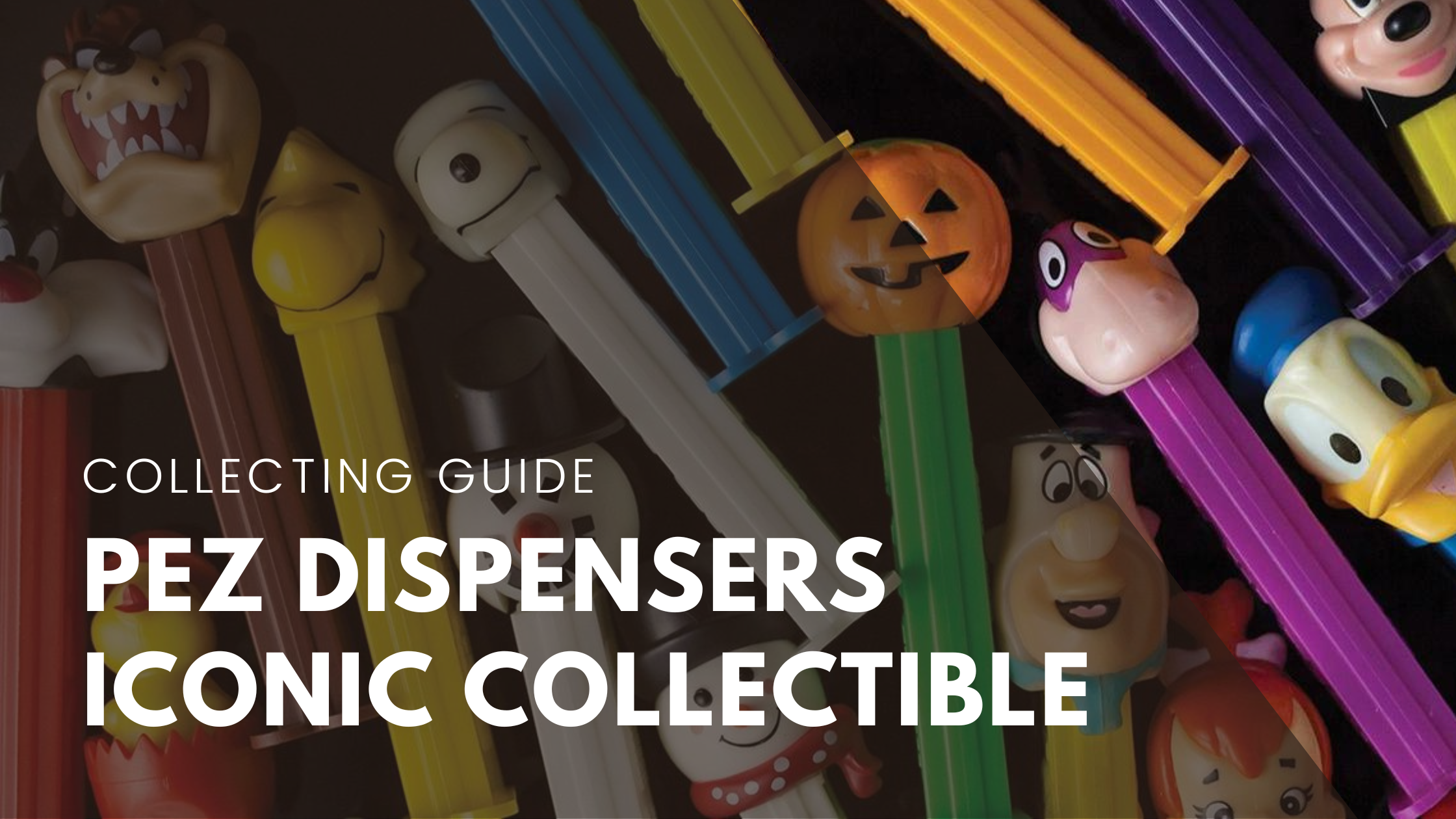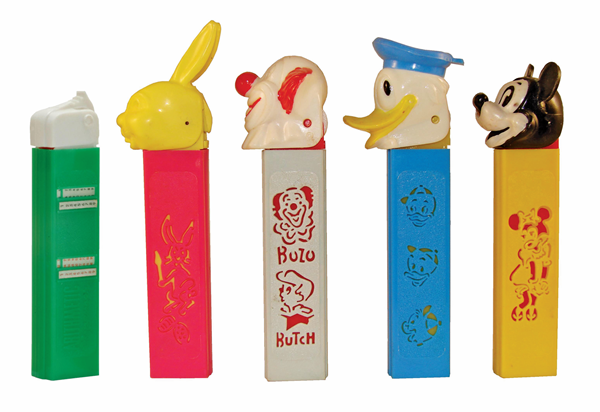Pez Dispensers: From Novelty to Iconic Collectibles
The history of Pez Dispensers is a delightful journey filled with nostalgia, innovation, and a touch of sweetness. Pez Dispensers have captured the hearts of enthusiasts from their humble beginnings in Austria to become a beloved icon in the world of collectibles.
These colorful candy dispensers have evolved in design and popularity over the years, reflecting society's ever-changing tastes and interests. A Pez Dispenser suits every collector's fancy, from classic characters to limited editions. Starting a collection is an enjoyable hobby and an opportunity to delve into these tiny marvels' rich history and cultural significance.
History of PEZ
Sold at retail and offered as a mail-in premium, this is the 1955 PEZ Golden Glow.
PEZ was first established in 1927 by Eduard Haas III in Vienna, Austria. Their first offering was as a peppermint-flavored breath mint sold in rolls as “Drops,” like Life Savers candy today. The company name PEZ came from the German word for peppermint, which is “pfeffermintz” Haas took the ‘p,’ ‘e,’ and ‘z’ to get the candy’s name. After eight years, the company was doing so well that it had to build an additional factory in Czechoslovakia to increase production. In the 1930s, the brick-shaped PEZ mints were sold in small tins that kept the candies clean while stored in the pocket.
Then in 1948, Oscar Uxa transformed the PEZ experience by creating the first iconic PEZ dispenser that doled out one piece of candy at a time. This was initially conceived as a sanitary measure to prevent people from touching every piece of candy while choosing one. This change also doubled as an anti-smoking campaign as the shape of a cigarette lighter inspired the new dispensers. The drive to get people to eat PEZ rather than smoke cigarettes was real. Advertisements for the candy at this time had the slogan, “No smoking, PEZing Allowed.”
PEZ made its way to the United States in 1952, setting up its first U.S. PEZ headquarters in New York City. Despite the success of PEZ in Europe, selling candy in the U.S. was problematic due to the strong peppermint flavor. To attract children to the brand, PEZ moved to the fruit-flavored version of the candy and character-themed dispensers we know today. Some of the earliest character dispensers came in the shape of robots and Santa Claus. Unlike the well-known dispensers that came later, the ones from 1955 were full-bodied characters.
A disassembled clear 1950s PEZ space gun is believed to be one of two examples.
To contemporary eyes, the most curious and even disturbing PEZ shape is the space gun from 1956, which came in a variety of colors and shot pieces of candy. Today, it may be hard to imagine a candy company expecting children to put the muzzle of a gun in their mouths and pull the trigger to eat its candy. However, in the late 1950s, when the space gun was changed to a handgun, this delivery device was considered good fun.
During the 1950s, as PEZ tried to gain a foothold in the United States, the candy flavors were expanded beyond a range of mints to include various fruits. And then came the characters: Popeye, a bunny, and a witch were among the first to be introduced at the end of the 1950s, followed by Casper the Friendly Ghost, Bozo the Clown, and several Disney characters, from Mickey Mouse to Donald Duck, at the beginning of the 1960s. Many of these dispensers had character heads and additional character images die-cut into their sides (for example, Huey, Dewie, and Louie appeared on the sides of Donald Duck dispensers).
Today, some of the most sought PEZ dispensers are from the 1950s and ’60s. One incredibly hard-to-find Regular PEZ from this era is the Golden Glow, which had a round gold base to display the dispenser almost like a sculpture. Wonder Woman and Thor dispensers are just two of the comic-book characters collected by fans. In contrast, the Psychedelic Hands dispensers from 1968, each of which holds an eyeball, are favorites of people who collect rock posters and ’60s psychedelia. In 1987, PEZ added feet to its dispensers, so that’s one easy way to date a dispenser.
Dating Vintage PEZ Dispensers
Much has been written on identifying and collecting PEZ since the first book by David Welch (Pictorial Guide to Plastic Candy Dispensers Featuring PEZ) appeared in the early 1990s. Most authors advise that correctly determining the age of a PEZ dispenser is somewhat frustrating, if not confusing. Although each PEZ candy dispenser is marked with a patent date, roughly indicating the time it was manufactured, more information is needed to determine its age. For example, the first patent number issued for the PEZ dispenser was 2,620,061 in 1952. The second patent issued was number 3,410,455 in 1968. Thus, it is logical to assume that all dispensers marked with the 2.6 patent number were manufactured between 1952 and 1968. This, unfortunately, is not entirely accurate. Starting approximately in 1987, the footless PEZ candy dispenser stems gradually phased out of production and replaced with PEZ dispensers with feet. Yet footed PEZ dispensers with 2.6, as well as 3.4 patent numbers, can be found. This means dispenser stems were sometimes made using old molds showing patent numbers out of chronological order to their actual production time.
Knowing the approximate timeline when a PEZ dispenser was produced can help enormously in estimating the age of particular dispensers. Some PEZ character heads were produced in minimal and short time frames. In his second book (Collecting PEZ), Welch lists the approximate production times for PEZ dispensers made up to 2002. For some dispensers, such as the Olympic PEZ (made in 1972, 1976, and 1984) and the rubber-headed Eerie Spectre's monster PEZ (1979), each production date is restricted to relatively narrow time frames. Many other PEZ dispensers, such as Santa C, were produced over long periods from approximately 1970 to about 1987 with a footless stem. Determining the correct vintage of such a dispenser takes a lot of work. But hints of age in some cases can be obtained by carefully examining the details of the stem and overall dispenser construction. The design of the candy pusher button, the type of head spring used, and even the country of origin, marked on most dispenser stems, can provide additional insight into age. However, just as in the case of patent numbers, these clues are not 100% foolproof. PEZ candy dispensers are manufactured as parts (head, stem, spring mechanism, etc.) and assembled. Whatever molds used for the stems that were available at the time of assembly, including different parts that may have been made much earlier, can often disguise the PEZ dispenser’s production age.
Anatomy of a PEZ Dispenser
Head
The head is the "character" of the dispenser. It could be an object (truck, whistle, cap, etc.), a character (Mickey, Tigger, Batman, etc.), or even an animal (monkey, giraffe, dinosaur, etc.). There's almost no end to what could be positioned as a head on a PEZ dispenser. (Look at "Fantasy" PEZ items.)
Stem
The stem is the "body," or central portion, of the dispenser. It is rectangular and has the word "PEZ" on both sides. One side features lettering spelled from top to bottom, while the other displays lettering sideways from bottom to top. The stem is also where you'll locate the patent number, country of origin, and (IMC) injection mold code.
Feet
The feet are the "base" of the dispenser. They are flat plastic pieces molded onto the bottom of the stem and resemble 'shoes.' The primary purpose of the feet is to support the stability of the dispenser while "standing." (They help it not fall over.) Initially, PEZ dispensers did not have feet. They were just "squared off" on the bottom and are called (NF) non-footed. Many collectors will have their non-footed PEZ fitted with "PEZ Shoes." These are blocks of plastic molded to work around the base of the stem. There are now many colors to choose from, and it should be noted that they are not "licensed" items from PEZ Co. The first style of feet used on a PEZ stem had a thin profile and were called "Thin Feet." Around 1990, PEZ started molding the feet with a thicker profile called "Thick Feet."
Inner Sleeve
The Inner Sleeve acts like a candy "tray" or "channel" for the actual PEZ Candy. It is attached to the head with a metal or plastic hinge pin and goes inside the stem. It has been produced in many colors and styles over the years.
Starting a PEZ Collection
You should know how to get started if you are a new collector. Start slowly; look for all the current release dispensers you can find around your town. That alone will give you a nice size collection to build without spending too much money.
Must collectors ask, “Should I leave it in the package or open it up? "Will it lose its value if I open it?" Opening the dispenser is a matter of preference. If the dispenser is old, I would advise against opening the package. With the new stuff, it's up to you. Many collectors buy at least three of each new release, one in the bag, one on the card to save, and one to open for display. A carded or bagged dispenser is traditionally worth more than one that is loose, but a dispenser out of the package is more fun to display.
Next, move on to the current European dispensers. Most of these can be had for $3 to S4 each. Acquire all of these, and the size of your collection will almost double.
When it comes to vintage dispensers, decide your first “price plateau” and start from there. For example, many footless dispensers can still be found for $25 or less. Once you buy all of these, move on to the next price level, and so on. Although some of the old dispensers reach into the hundreds and even thousands of dollars for one, you don‘t have to spend your life savings to enjoy the hobby.
Some collectors specialize in collecting one favorite area, such as the Animals or PEZ Pal series. Others focus on stems by collecting a character made in several countries or as many different colors as possible. A good example of this is the Teenage Mutant Ninja Turtles. Eight different dispensers come in eight different stem colors; if you were to collect all the combinations, you would have 64 turtles alone in your collection!
The most important thing to remember about collecting PEZ: collect what you enjoy and enjoy what you collect but most importantly, it's a hobby, have fun!
Beware of Fake PEZ
Some people have been making and selling reproduction parts for PEZ and, more recently, fake or reproduction vintage dispensers. Trust your instinct. If you think an item is questionable, it is better to pass than find out later that you have been taken. Know what you are buying and know what a piece should look like. Remakes and fakes are not limited to just parts; whole dispensers have recently surfaced that are fakes. Some vintage dispenser remakes include but are not limited to, One-Eyed Monsters, Indian Chiefs, Mimic the Monkey, and 1950s Space Guns.
Only knowledge, experience, and buying from a well-known, reputable dealer will help you avoid having a reproduction or fake unknowingly passed on. Common reproduction parts include but are not limited to the Ringmaster's mustache, the Mexican's goatee and earrings, the Policeman's and Fireman's hat badges, the Knight's plume, the Doctor’s reflector, and Batman’s cape. Most parts are not labeled as reproductions. For instance, a remake of the doctor's mirror may be made of aluminum instead of plastic, and the reproduction capes for Batman are usually much thicker than the vintage capes. The quality of reproduction parts has undoubtedly improved. Studying pictures in books and attending PEZ conventions are your best sources for comparing dispensers.
Fantasy PEZ Dispensers
For example, some dispensers, such as KISS or the Beatles, were never made by PEZ but can be found easily. How can this be? When a dispenser of a particular character or person is in demand but does not exist, collectors have sometimes resorted to making their dispensers. These are known as ‘fan-made" or “fantasy" pieces. Again, some of these pieces are better made than others; some are pretty good. You can even find fantasy pieces that are mint on a very convincing PEZ card or even in a sealed poly bag, but PEZ never made them.
Although these fantasy PEZ are not considered real PEZ dispensers, they have been known to catch a fair price by PEZ collectors. There are a variety of reasons fantasy PEZ dispensers are created. Some people love to be creative and show off their artistic talents, while others want to add variety to their PEZ collections. It's always nice to show off some PEZ that no one has seen before or to have a character that PEZ has yet to put on a dispenser.
Remember, collecting Pez Dispensers is about more than just the physical objects themselves; it's about connecting with the past, cherishing childhood memories, and embracing the joy of sharing with others who appreciate these whimsical treasures.
So, start your collection with enthusiasm and curiosity. Immerse yourself in the rich history, seek out the rare and special pieces, and enjoy the journey of discovering the wide range of Pez Dispensers waiting to be collected.
Let the nostalgia and sweetness of Pez Dispensers fill your world as you embark on this delightful adventure of collecting these iconic candy companions. Happy collecting!










